With millions of active users, Pinterest is a great platform to do affiliate marketing and make money. The best part is that it’s easy to learn and totally free to set up.
This post will guide you through the detailed step-by-step process on how to do affiliate marketing on Pinterest successfully.
What is Pinterest affiliate marketing?
Pinterest affiliate marketing is the activity of promoting other people’s products or services on Pinterest to earn commissions. You find an affiliate offer related to your Pinterest audience and create content around it. Then, you incentivize them to make purchases through your affiliate link to make money.
People who purchase through your affiliate link don’t have any drawbacks compared to a direct link. In fact, you can even make a deal with affiliate merchants or networks to offer unique discounts for your audience. Ultimately, it’s a win-win situation for both parties. You earn money while providing extra benefits to your Pinterest audience.
How does Pinterest affiliate marketing work?
Affiliate marketing on Pinterest works similarly to any other type of affiliate marketing.
You find good affiliate marketing products or services from networks such as Amazon Associates, ClickBank, ShareASale, or companies that provide affiliate programs. Then, you get your unique affiliate links that help track clicks, click sources, commissions, etc. Finally, you create Pinterest Pins and promote them to your audience to make money.
The process is as simple as that!
The most important thing is that you choose suitable affiliate marketing offers and create great Pinterest content that can attract people to click on.
Why you should try affiliate marketing on Pinterest
There are 2 main reasons why you should try affiliate marketing on Pinterest.
First, let’s talk a little bit about the advantages of affiliate marketing.
Affiliate marketing is a business model that is relatively easy to learn and set up without requiring much up-front capital. It also has the potential to scale automatically and effortlessly because of the way it works.
The second reason lies in Pinterest itself.
Launched in March 2010, Pinterest was the fastest website in history to reach 10 million unique monthly visitors. Nowadays, the platform is one of the largest and most engaging social networks with more than 416 million monthly active users.
In addition to such impressive feats, 64% of Pinterest users also describe the website as a place to find ideas, products, or services they can trust. Furthermore, 98% of them would like to try new things they find on Pinterest.
With all of that metrics, Pinterest is definitely a lucrative opportunity for any business as a whole and affiliate marketing in particular.
How to do affiliate marketing on Pinterest successfully
These are 9 steps to help you do affiliate marketing on Pinterest successfully.
- Research profitable topics on Pinterest
- Find a potential affiliate marketing product to promote
- Assess the affiliate marketing offer
- Get your affiliate link
- Find affiliate marketing materials
- Create a great landing page for your affiliate marketing offer
- Set up your Pinterest account correctly for affiliate marketing
- Create great Pinterest content
- Publish your Pins
- Drive traffic to your Pins
- Analyze your results
1. Research profitable topics on Pinterest
The first thing you need to care about when doing affiliate marketing on Pinterest is researching topics that can attract Pinterest users. This is important because not every social platform works the same way. Furthermore, users on different platforms are widely diversified in terms of genders, ages, behaviors, countries, and especially interests.
Pinterest user genders

According to Statista, 77% of Pinterest users are female. It means that when choosing an affiliate offer to promote on Pinterest, it would be best to pick one that can attract females or both genders. For example, you might have a hard time finding the right audience for video gaming or woodworking products/services.
Pinterest user ages

The average age of Pinterest users is 40, and the majority of active pinners are below 40. Therefore, you should pick affiliate offers that suit this age range.
Pinterest user behaviors
85% of Pinners use Pinterest mobile app. Therefore, make sure you promote things that are quick to catch people’s attention and easy to follow on mobile devices.
Pinterest categories
Currently, there are more than 30 main categories and interests on Pinterest, including Animals & Pets, Architecture, Art, Beauty, Finance, Gardening, Design, Photograph, Sport, Quotes, Travel, Vehicles, and more.
However, the 10 most popular Pinterest categories in order are Food & Drink, Home Decor, Travel, Health & Fitness, Women’s Fashion, Hair & Beauty, DIY & Crafts, Entertainment, Weddings, and Holidays & Events.
If you want to explore all Pinterest categories and interests yourself, a method you can use is to convert your Pinterest account to a business one. Next, create a dummy ad campaign by clicking on the “create ad” button in the “Ads” tab.

Then scrolling down the page a little bit. You can see the “interests” section.

Now, you can freely explore every category and interest that Pinterest provides.
It might seem like a good idea to target the most popular Pinterest categories mentioned earlier. However, it also means that you will have more competitions. If you cannot find a good angle to promote your affiliate marketing offers, it’ll be hard to get people to click on your Pinterest pins instead of others in the same niche. In that case, it would be better to find a less competitive category.
Picking which category to focus on totally depends on you. However, in the beginning, we recommend you choose one with moderate to low levels of competitiveness. In that way, you have an easier time competing with other advertisers.
To check how competitive a category is, select one from the “interests” section and look at the audience size in the right panel.

The larger the audience size, the more competitive a category is.
In our opinion, a category with an audience size of below 30 million is a good choice for beginners.
You can also go to Pinterest Audience insights by clicking on “Analytics,” select “Audience insights,” and then switch to “All Pinterest users” to access more in-depth information on this topic.

Pinterest keyword research
Doing keyword research will not only give you a general idea of how appealing your affiliate offer is to Pinterest users. It also helps you optimize your Pins for the Pinterest search engine to gain better results.
To start doing keyword research, create a dummy ad as earlier. Then, scroll down the ad page a little bit. You should see a keyword section.

Just enter a keyword into the search bar and hit Enter. Related keywords, along with the number of monthly searches, will appear below your seed keyword.
In general, you should start with keywords that have below 500k monthly searches. Any keyword with searches above that number is very competitive.
2. Find a potential affiliate marketing product to promote
After having a general idea of which category and which type of product or service to target, it’s time for you to actually find a great affiliate marketing offer.
In this post, we’ll use ClickBank as an example. But, you should go through all affiliate networks to find offers that suit your need.
If you didn’t have a ClickBank account, click the “Sign up” button on the top right corner of its homepage to create one. Then, visit ClickBank’s affiliate marketplace by clicking on “Affiliate Marketplace” inside the ClickBank dashboard or visiting this ClickBank Marketplace direct link.
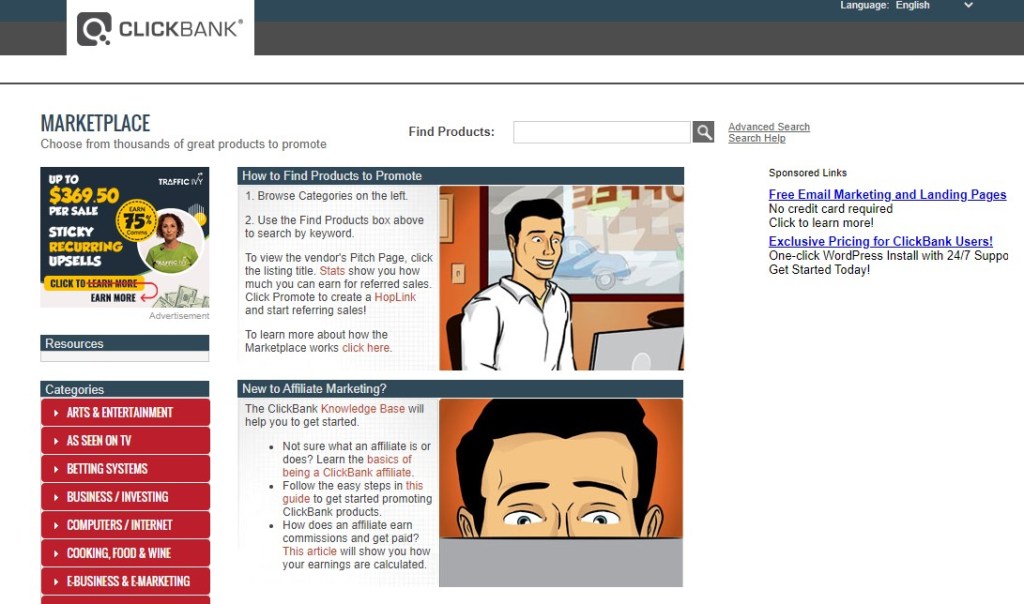
On the left panel, you can see a list of categories to choose from. When clicking on one category, the “Filters & Attributes” panel will appear, allowing you to quickly filter through all offers.

The “Gravity” score is a relative ClickBank-generated metric indicating how many affiliates have successfully promoted a product. In general, the higher the score, the better the offer will convert.
So, do you have to be concerned about products with high gravity scores as they might be too competitive?
If you decide to run Facebook or Google ads for those products, it would be wise to assess the competition. However, in the case of Pinterest organic traffic, the answer is no. The reason is that your affiliate marketing offers will appear as usual Pinterest Pins (Note that you still have to disclose this to your audience).
For example, with the “Get Paid To Use Facebook, Twitter, And Youtube” affiliate offer, you probably create Pins like “Ways to make money from home” or “How to get paid using Facebook.” The competition now becomes more of a Pin and keyword game rather than the competition of the product itself.
Another metric you should pay attention to is Avg $/Conversion. This number represents the average commission an affiliate earns for each conversion they make, including earnings from initial sales, upsells, and rebills.
Finally, it’s the “Support for mobile traffic” attribute. It indicates whether the vendor has provided a mobile version of their landing page. When someone clicks on an affiliate link, ClickBank will automatically detect the device type of that person. If it’s a mobile device, they will be redirected to the mobile version of the URL for a better user experience.
Although it’s OK to promote a non-mobile-optimized affiliate marketing offer, it’s always better to pick one that people will have the best experience with, especially for Pinterest users.
To learn more about other ClickBank metrics, visit How to use ClickBank search functions.
3. Assess the affiliate marketing offer
The next step is to evaluate the product you have got your eyes on.
Not all affiliate products are the same. Some are legit, and others are solely made to make money. Although you are free to promote any affiliate offer, it’s best to choose one that provides real value to customers.
There are 2 ways to assess the quality of an affiliate product.
The first method is to search for reviews of the product on Google and YouTube. If all review articles and videos say that it’s legit, you’re good to go.
The second method is to try the product yourself. You don’t need to pay for it, though. More often than not, if you send an email to the product owner saying that you’re an affiliate and asking to try the product in a short period of time, like 3 days or 7 days, they’ll gladly respond. If they don’t, you should move on to find another offer as it’s very likely that the owner is a scammer and afraid to give you access.
4. Get your affiliate link
Affiliate marketing networks make it very easy for you to get your own affiliate link for a specific product. For example, in the ClickBank marketplace, just click on the “Promote” button of an offer you are interested in.
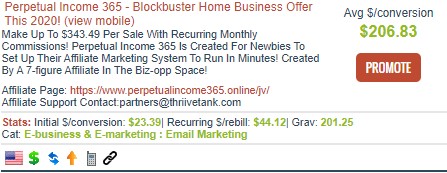
A hoplink generator will appear, allowing you to generate your own affiliate link.

If you haven’t created an account nickname yet, go to the ClickBank dashboard, then click on the “Accounts” tab and create one.

The tracking ID is an optional parameter that can help you better track your activity. Suppose you promote your affiliate marketing offer on Facebook and Pinterest. You can create 2 distinct affiliate links by entering 2 different tracking IDs. Doing this can help you assess the performance of each platform separately later.
After entering your account nickname and an optional tracking ID, click “Generate HopLinks” to generate your affiliate link.
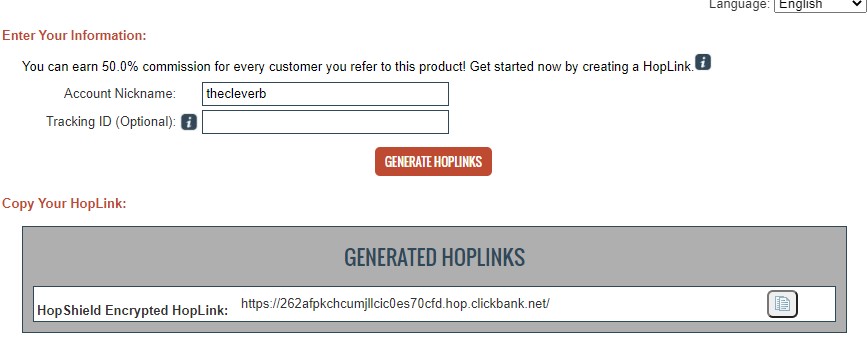
Now you have your own affiliate link ready to be promoted to your Pinterest audience.
Getting affiliate links on other networks should be more or less the same.
5. Find affiliate marketing materials
An affiliate offer usually comes with marketing materials such as email templates, banners, and testimonials to help you get started quickly. These can often be found easily under the offer.

Sometimes, the affiliate program requires you to sign up to get your materials. Don’t hesitate and just enter your information. You’ll usually get accepted to the program immediately. Note that if you are asked to provide your ClickBank ID, it’s your account nickname.

Here is an example of email templates.

With these materials, you can build a high-converting landing page for your affiliate marketing offer.
6. Create a great landing page for your affiliate marketing offer
A landing page is a single web page designed specifically for a marketing campaign.
Although it’s possible to send your customers directly to the offer with your affiliate link, creating your own landing page and send people to this page first gives you many advantages.
First, it gives you an opportunity to collect emails from your customers. People usually hesitate the first time they see a product. With email marketing, you can remind them about the offer and increase your chance of making sales. Furthermore, the emails you have collected can be used for future promotions.
Secondly, it makes your affiliate offer more trustworthy. If your Pinterest audience lands on another website immediately without proper explanation, they might be confused and skeptical about the product.
Understanding the importance, there are 2 main methods to create a great landing page.
The first method is to start a blog (or a website), and we recommend going this route. The reason is that blogging is a great way to build a strong relationship with your audience and achieve long-term success. You can follow this How to Start a Blog for Free guide to create one for free. Otherwise, follow this Start a Blog with BlueHost guide to set up a paid one and have complete control over every part of your blog.
The second method is to use a landing page builder such as ClickFunnels or Leadpages. They provide a wide variety of tools to help you quickly set up a high-converting landing page, collect email leads, and analyze results.
Here is an example landing page for the affiliate offer Perpetual Income 365.

We just took affiliate marketing materials provided by the affiliate merchant and put them together to create a great landing page.
If you want to collect emails from visitors, just show a signup form when people click on the CTA (Call To Action) button. Then, tell them to enter their information first before being directed to the affiliate page.
It’s important to note that some affiliate offers like “Perpetual Income 365” have already provided visitors with their own email signup form. In this case, it might not be a good idea to show your email form as it will require people to enter their information twice. The key here is to test and see what works best for you.

7. Set up your Pinterest account correctly for affiliate marketing
Setting up your Pinterest account correctly can significant increase the visibility of your Pins.
First, switch your Pinterest account to a business one. This will allow you to access all of the advanced tools Pinterest offers.
Make sure that you fill in all of the information fields in your Pinterest profile, especially your username, display name, and description.

Pinterest will look at your profile as one of many SEO factors to decide the relevancy of your content. Therefore, it’s best to include some relevant keywords in your display name and description. For example, if you promote an affiliate marketing offer related to making money online, some keywords to include in your Pinterest profile can be “make money online,” “make money from home,” or “earn cash online.”
The next step is to claim your website so that Pinterest can give credit to your content properly. When you claim your content, your name and profile picture will show up next to any Pins from your site or external accounts.

Next is to create Pinterest boards. They are similar to folders where you save and organize your Pins. Many successful Pinterest brands suggest that your account should have at least 15-20 boards.

When creating Pinterest boards, it’s also important to give them names and descriptions related to your affiliate marketing topic.
Another important thing you should do is to install Rich Pins. This feature allows for showing metadata right on your Pins, giving Pinners a richer experience and increasing engagement.
We suggest that you use Tailwind to help you during the Pinterest profile setup process. It’s a smart social media scheduling tool that allows for posting automation, audience analysis, Pinterest account monitoring to give you suggestions on how to improve it, and more.
After signing up for Tailwind, it will immediately guide you through every step to set up your Pinterest account quickly and correctly for your affiliate marketing business.

8. Create great Pinterest content
There are hundreds of thousands of Pins published on Pinterest every single day. Therefore, to stay on top of the competition, your Pins not only have to be beautiful. They also need to follow various criteria, and most importantly, include relevant keywords.
Pinterest community guidelines
Since users are the lifeblood of any social media network, including Pinterest, the platform strictly monitors the content being published to ensure Pinners’ safety.
Before creating Pins, we recommend that you read Pinterest community guidelines thoroughly to avoid violating rules and getting your account banned.
As an affiliate, you should pay close attention to some rules below:
- Adult content: You are allowed to save content about sexual health, breastfeeding, mastectomies, art, etc. However, they are still somewhat limited by Pinterest, and explicit adult content is a no on the platform.
- Dangerous content: Pinterest limits content that purposely shows the use of violence. It also restricts the distribution of alcohol, tobacco, drugs, weapons, etc.
- Misinformation: Pinterest removes or limits the distribution of false or misleading content. These might include conspiracy theories, medically unsupported health claims, illegal information, etc.
- Impersonation: Pinterest doesn’t allow accounts that impersonate or misrepresent their affiliation with any person or organization.
- Spam: Pinterest doesn’t allow spamming or engaging in spammy behaviors, such as creating or saving content that is repetitive, deceptive, linking to websites that are unsafe, untrustworthy, using automation that hasn’t been explicitly approved by Pinterest (List of approved Pinterest partner tools here).
- Paid Partnership and Affiliate guidelines: All promotional content must disclose its commercial nature, such as in the title or description of the Pin. You are also not allowed to use shortened or redirect links that make the destination domain unclear. In short, make sure that your affiliate marketing Pinterest content is authentic and transparent.
Pin design
To quickly design beautiful Pinterest Pins, you can use tools like Canva or Tailwind. They offer various ready-made templates, images, and other elements that are optimized for Pinterest.

It’s important to note that Pinterest considers Pins with different designs as “fresh” Pins. Therefore, even if your Pins have the same titles, descriptions, website links but different designs, you will be safe from being a spammer. Tools we just mentioned above also give you the ability to quickly switch between different designs so you can create fresh Pins in minutes.
Pinterest algorithm
Pinterest has its own algorithm to rank content published on the platform. Although no one knows exactly how the algorithm works, there are some factors either discovered by experts or stated by the Pinterest team that affect the visibility of Pins.
- Domain quality: Pinterest uses your website and Pins to determine the quality of your account. By setting up your Pinterest account correctly and creating a safe and active website, you can increase your domain quality.
- Pin quality: The more relevant, useful, and engaging your Pins are, the higher the quality Pinterest will consider them to be.
- Pinner quality: The more active and consistent you are in creating and pinning high-quality content, the better it is.
- Pinterest Lens: Besides factors like titles and descriptions of your profile or your board, Pinterest dissects your Pins to see how relevant they are. This includes things like text overlays and elements on your Pin images. Therefore, make sure they are also related to the content you promote.
Knowing the Pinterest algorithm can help you make your content better and rank higher.
Pinterest keywords
Using the right keywords is one of the most important things when pinning on Pinterest. It doesn’t only help Pinterest rank your content properly, but it can also give you a better chance to out-rank your competitors.
Like we have mentioned earlier, it’s best to choose keywords that are not too competitive, but people also search for.
Retake the “Perpetual Income 365” offer as an example. The main topic of this affiliate marketing product is making money online. By doing quick research for the terms “make money online,” you can get back some related keywords such as “extra income ideas,” “make more money,” “make quick cash,” “income from home,” or “earn cash online.”
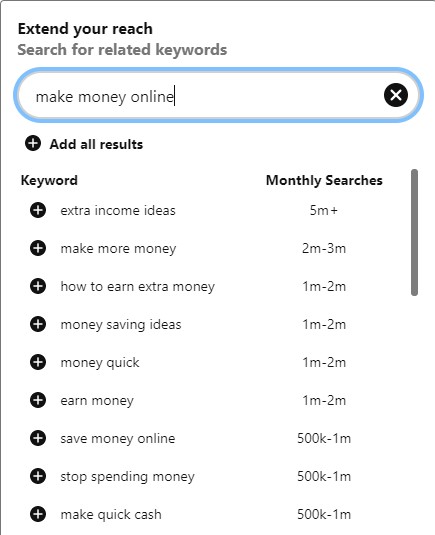
Each keyword has different numbers of monthly searches. Although all can be used to promote the affiliate offer, you should start with ones with less than 500k monthly searches like “income from home” or “earn cash online” as they are less competitive.
You should also look at search results for all keywords to have a general idea of the competition and where you can potentially improve.
Below is the search result for “make money online.” You can see that all of the top Pins have images, titles, and descriptions closely related or exactly matching the search term.

And here is the search result for “earn cash online.”

Although the top Pins have descriptions closely related to the search term, all of them don’t have the exact match keyword on the Pin images. Some don’t even have the keyword in the Pin title. This is your chance to compete for a top spot.
For example, if we were to compete for this keyword, below would be our pin.

We would then give it a title like “How to earn cash online” or “The secret way to earn cash online.” And, remember to mention this keyword multiple times in the Pin description.
Supplemental valuable content
Although you can create hundreds or even thousands of beautiful Pins for one affiliate marketing offer, it’s hard for Pinterest to consider your account as high-quality because your Pins don’t bring much value to people.
If you want your account to get noticed by Pinterest and your content to be shown more regularly in front of Pinterest users, it’s crucial that you start creating additional valuable content.
Suppose you are promoting a weight-loss-related product. You could write blog posts about “how to lose weight,” “tips for losing weight,” or “diet for losing weight” and create Pins around these. If you don’t like the idea of writing blog posts, creating infographic images is another method you can use. As long as you create useful and high-quality content consistently, Pinterest will start to notice your account and show your content to more people.
9. Publish your Pins
It’s easy to publish your content on Pinterest. However, how many Pins you should publish a day can be a tricky question.
In general, it’s recommended that you should aim to pin between 15-25 Pins per day. The number looks daunting. However, it’s relatively easy to achieve it.
First, if you pin your Pin to a different board (remember that your account should have at least 15-20 boards), it will still count as a publish action. It’s important to note that a Pin shouldn’t be pinned in more than 10 boards.
Second, they don’t have to be all your Pins. You can repin other people’s content related to your topic, and Pinterest will still give you credit for doing this. At the end of the day, it’s also a way to contribute to the Pinterest community.
For example, you have 3 pieces of content to promote (1 affiliate marketing offer and 2 informational posts), and you create 5 Pins for each. Suppose you intend to pin these pieces of content to 10 relevant boards. Ultimately, if you publish 3 of your Pins each day, it would take you 50 days to finish pinning all of your content. To fulfill the plan of pinning at least 15 Pins per day, you can curate 12 more Pins from other Pinners.
That’s the idea!
When you have more content, you can choose to pin more frequently or start pinning less other people’s Pins and focus more on your content.
You can also automate this process using Tailwind. It provides advanced tools to help optimize your publishing time slots so your Pins can reach the most people, curate additional content in just a few clicks, and set your Pin schedule on autopilot so you don’t need to worry about publishing Pins manually.

10. Drive traffic to your Pins
Besides creating great content and using the right keywords, there are 3 more ways to get your Pins more exposure.
The first one is to find and join popular group boards related to your topic and start contributing. Since these Pinterest group boards have already had a lot of followers, your content can gain tons of impressions.
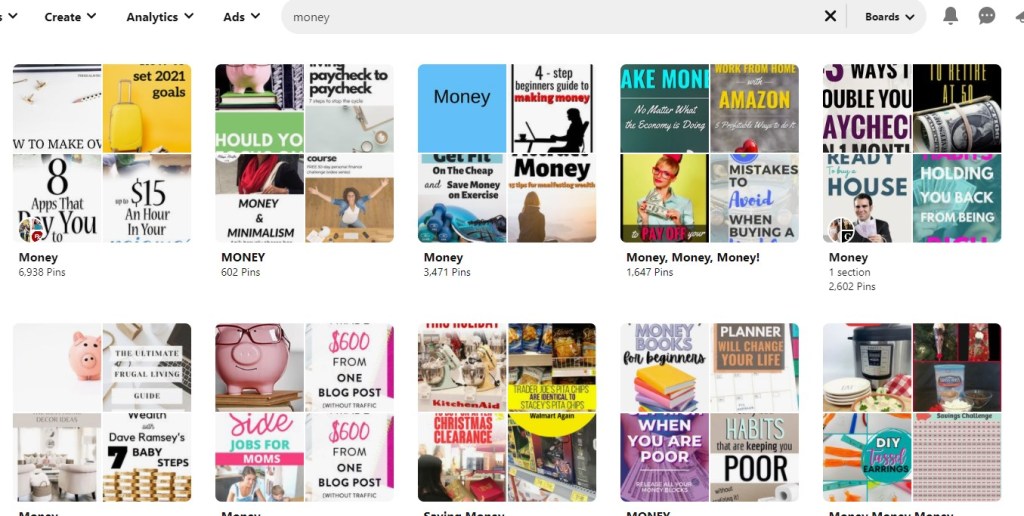
To find group boards to join, simply type a keyword into the Pinterest search field and switch the filter to “Boards.”

The second method is to use Pinterest Ads. They look like regular Pins that you pay to be placed where users are most likely to see them. Using Ads is the quickest way to get your Pins in front of the right customers.
Finally, we have Tailwind Tribes. They are communities where you can find like-minded people, start connecting, sharing your Pins, attract followers, and get your Pins shared by other successful Pinners.

11. Analyze your results
Pinterest has built-in analytics tools to help you measure your pin performance, the number of impressions, engagements, and your audience size. Using Pinterest Analytics, you know how your Pins and boards perform and use that data to optimize your profile accordingly.

Tailwind also has its own analytics tools that let you see even more advanced metrics such as virality score, engagement score, engagement rate, organic activity, and more.

The idea here is to keep pinning your popular Pins to your best performing boards and gradually archive underperforming boards (don’t remove your board because you will lose followers that follow that board). For Pins that don’t perform well, you can try changing their designs, keywords, or even switching to different content that can attract more attention.
Affiliate marketing on Pinterest – Conclusion
Affiliate marketing on Pinterest is a good time and effort investment opportunity. It’s easy to set up and doesn’t require rocket-science knowledge to understand and do it successfully. With an entrepreneurial mind and a will to try it, you can learn a lot and make money along the way.
The rightful owner of The Clever Business. I review & curate the leading suppliers so you don't waste time scouring the internet.


